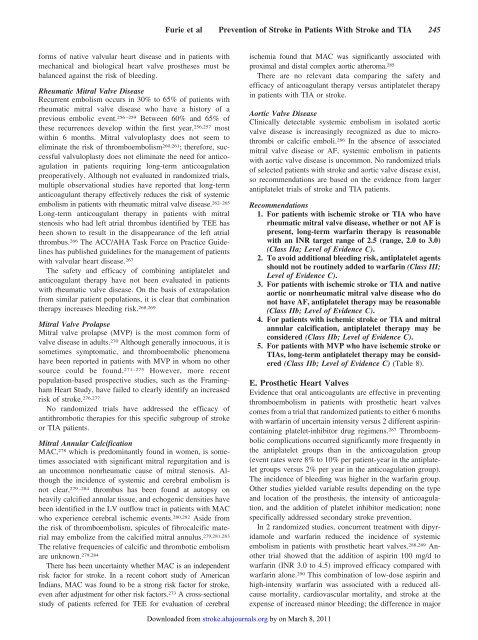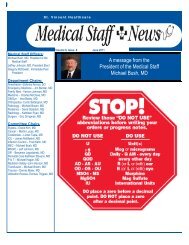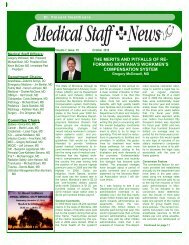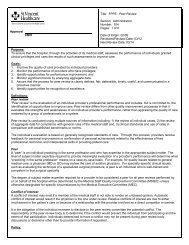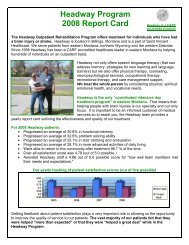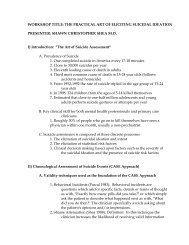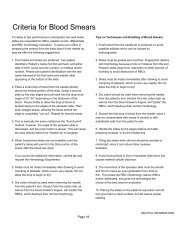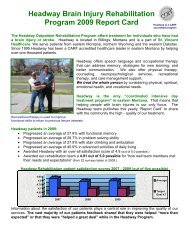AHA/ASA Guideline Guidelines for the Prevention of Stroke in ...
AHA/ASA Guideline Guidelines for the Prevention of Stroke in ...
AHA/ASA Guideline Guidelines for the Prevention of Stroke in ...
You also want an ePaper? Increase the reach of your titles
YUMPU automatically turns print PDFs into web optimized ePapers that Google loves.
Furie et al <strong>Prevention</strong> <strong>of</strong> <strong>Stroke</strong> <strong>in</strong> Patients With <strong>Stroke</strong> and TIA 245<strong>for</strong>ms <strong>of</strong> native valvular heart disease and <strong>in</strong> patients withmechanical and biological heart valve pros<strong>the</strong>ses must bebalanced aga<strong>in</strong>st <strong>the</strong> risk <strong>of</strong> bleed<strong>in</strong>g.Rheumatic Mitral Valve DiseaseRecurrent embolism occurs <strong>in</strong> 30% to 65% <strong>of</strong> patients withrheumatic mitral valve disease who have a history <strong>of</strong> aprevious embolic event. 256–259 Between 60% and 65% <strong>of</strong><strong>the</strong>se recurrences develop with<strong>in</strong> <strong>the</strong> first year, 256,257 mostwith<strong>in</strong> 6 months. Mitral valvuloplasty does not seem toelim<strong>in</strong>ate <strong>the</strong> risk <strong>of</strong> thromboembolism 260,261 ; <strong>the</strong>re<strong>for</strong>e, successfulvalvuloplasty does not elim<strong>in</strong>ate <strong>the</strong> need <strong>for</strong> anticoagulation<strong>in</strong> patients requir<strong>in</strong>g long-term anticoagulationpreoperatively. Although not evaluated <strong>in</strong> randomized trials,multiple observational studies have reported that long-termanticoagulant <strong>the</strong>rapy effectively reduces <strong>the</strong> risk <strong>of</strong> systemicembolism <strong>in</strong> patients with rheumatic mitral valve disease. 262–265Long-term anticoagulant <strong>the</strong>rapy <strong>in</strong> patients with mitralstenosis who had left atrial thrombus identified by TEE hasbeen shown to result <strong>in</strong> <strong>the</strong> disappearance <strong>of</strong> <strong>the</strong> left atrialthrombus. 266 The ACC/<strong>AHA</strong> Task Force on Practice <strong>Guidel<strong>in</strong>e</strong>shas published guidel<strong>in</strong>es <strong>for</strong> <strong>the</strong> management <strong>of</strong> patientswith valvular heart disease. 267The safety and efficacy <strong>of</strong> comb<strong>in</strong><strong>in</strong>g antiplatelet andanticoagulant <strong>the</strong>rapy have not been evaluated <strong>in</strong> patientswith rheumatic valve disease. On <strong>the</strong> basis <strong>of</strong> extrapolationfrom similar patient populations, it is clear that comb<strong>in</strong>ation<strong>the</strong>rapy <strong>in</strong>creases bleed<strong>in</strong>g risk. 268,269Mitral Valve ProlapseMitral valve prolapse (MVP) is <strong>the</strong> most common <strong>for</strong>m <strong>of</strong>valve disease <strong>in</strong> adults. 270 Although generally <strong>in</strong>nocuous, it issometimes symptomatic, and thromboembolic phenomenahave been reported <strong>in</strong> patients with MVP <strong>in</strong> whom no o<strong>the</strong>rsource could be found. 271–275 However, more recentpopulation-based prospective studies, such as <strong>the</strong> Fram<strong>in</strong>ghamHeart Study, have failed to clearly identify an <strong>in</strong>creasedrisk <strong>of</strong> stroke. 276,277No randomized trials have addressed <strong>the</strong> efficacy <strong>of</strong>antithrombotic <strong>the</strong>rapies <strong>for</strong> this specific subgroup <strong>of</strong> strokeor TIA patients.Mitral Annular CalcificationMAC, 278 which is predom<strong>in</strong>antly found <strong>in</strong> women, is sometimesassociated with significant mitral regurgitation and isan uncommon nonrheumatic cause <strong>of</strong> mitral stenosis. Although<strong>the</strong> <strong>in</strong>cidence <strong>of</strong> systemic and cerebral embolism isnot clear, 279–284 thrombus has been found at autopsy onheavily calcified annular tissue, and echogenic densities havebeen identified <strong>in</strong> <strong>the</strong> LV outflow tract <strong>in</strong> patients with MACwho experience cerebral ischemic events. 280,282 Aside from<strong>the</strong> risk <strong>of</strong> thromboembolism, spicules <strong>of</strong> fibrocalcific materialmay embolize from <strong>the</strong> calcified mitral annulus. 279,281,283The relative frequencies <strong>of</strong> calcific and thrombotic embolismare unknown. 279,284There has been uncerta<strong>in</strong>ty whe<strong>the</strong>r MAC is an <strong>in</strong>dependentrisk factor <strong>for</strong> stroke. In a recent cohort study <strong>of</strong> AmericanIndians, MAC was found to be a strong risk factor <strong>for</strong> stroke,even after adjustment <strong>for</strong> o<strong>the</strong>r risk factors. 273 A cross-sectionalstudy <strong>of</strong> patients referred <strong>for</strong> TEE <strong>for</strong> evaluation <strong>of</strong> cerebralischemia found that MAC was significantly associated withproximal and distal complex aortic a<strong>the</strong>roma. 285There are no relevant data compar<strong>in</strong>g <strong>the</strong> safety andefficacy <strong>of</strong> anticoagulant <strong>the</strong>rapy versus antiplatelet <strong>the</strong>rapy<strong>in</strong> patients with TIA or stroke.Aortic Valve DiseaseCl<strong>in</strong>ically detectable systemic embolism <strong>in</strong> isolated aorticvalve disease is <strong>in</strong>creas<strong>in</strong>gly recognized as due to microthrombior calcific emboli. 286 In <strong>the</strong> absence <strong>of</strong> associatedmitral valve disease or AF, systemic embolism <strong>in</strong> patientswith aortic valve disease is uncommon. No randomized trials<strong>of</strong> selected patients with stroke and aortic valve disease exist,so recommendations are based on <strong>the</strong> evidence from largerantiplatelet trials <strong>of</strong> stroke and TIA patients.Recommendations1. For patients with ischemic stroke or TIA who haverheumatic mitral valve disease, whe<strong>the</strong>r or not AF ispresent, long-term warfar<strong>in</strong> <strong>the</strong>rapy is reasonablewith an INR target range <strong>of</strong> 2.5 (range, 2.0 to 3.0)(Class IIa; Level <strong>of</strong> Evidence C).2. To avoid additional bleed<strong>in</strong>g risk, antiplatelet agentsshould not be rout<strong>in</strong>ely added to warfar<strong>in</strong> (Class III;Level <strong>of</strong> Evidence C).3. For patients with ischemic stroke or TIA and nativeaortic or nonrheumatic mitral valve disease who donot have AF, antiplatelet <strong>the</strong>rapy may be reasonable(Class IIb; Level <strong>of</strong> Evidence C).4. For patients with ischemic stroke or TIA and mitralannular calcification, antiplatelet <strong>the</strong>rapy may beconsidered (Class IIb; Level <strong>of</strong> Evidence C).5. For patients with MVP who have ischemic stroke orTIAs, long-term antiplatelet <strong>the</strong>rapy may be considered(Class IIb; Level <strong>of</strong> Evidence C) (Table 8).E. Pros<strong>the</strong>tic Heart ValvesEvidence that oral anticoagulants are effective <strong>in</strong> prevent<strong>in</strong>gthromboembolism <strong>in</strong> patients with pros<strong>the</strong>tic heart valvescomes from a trial that randomized patients to ei<strong>the</strong>r 6 monthswith warfar<strong>in</strong> <strong>of</strong> uncerta<strong>in</strong> <strong>in</strong>tensity versus 2 different aspir<strong>in</strong>conta<strong>in</strong><strong>in</strong>gplatelet-<strong>in</strong>hibitor drug regimens. 287 Thromboemboliccomplications occurred significantly more frequently <strong>in</strong><strong>the</strong> antiplatelet groups than <strong>in</strong> <strong>the</strong> anticoagulation group(event rates were 8% to 10% per patient-year <strong>in</strong> <strong>the</strong> antiplateletgroups versus 2% per year <strong>in</strong> <strong>the</strong> anticoagulation group).The <strong>in</strong>cidence <strong>of</strong> bleed<strong>in</strong>g was higher <strong>in</strong> <strong>the</strong> warfar<strong>in</strong> group.O<strong>the</strong>r studies yielded variable results depend<strong>in</strong>g on <strong>the</strong> typeand location <strong>of</strong> <strong>the</strong> pros<strong>the</strong>sis, <strong>the</strong> <strong>in</strong>tensity <strong>of</strong> anticoagulation,and <strong>the</strong> addition <strong>of</strong> platelet <strong>in</strong>hibitor medication; nonespecifically addressed secondary stroke prevention.In 2 randomized studies, concurrent treatment with dipyridamoleand warfar<strong>in</strong> reduced <strong>the</strong> <strong>in</strong>cidence <strong>of</strong> systemicembolism <strong>in</strong> patients with pros<strong>the</strong>tic heart valves. 288,289 Ano<strong>the</strong>rtrial showed that <strong>the</strong> addition <strong>of</strong> aspir<strong>in</strong> 100 mg/d towarfar<strong>in</strong> (INR 3.0 to 4.5) improved efficacy compared withwarfar<strong>in</strong> alone. 290 This comb<strong>in</strong>ation <strong>of</strong> low-dose aspir<strong>in</strong> andhigh-<strong>in</strong>tensity warfar<strong>in</strong> was associated with a reduced allcausemortality, cardiovascular mortality, and stroke at <strong>the</strong>expense <strong>of</strong> <strong>in</strong>creased m<strong>in</strong>or bleed<strong>in</strong>g; <strong>the</strong> difference <strong>in</strong> majorDownloaded from stroke.ahajournals.org by on March 8, 2011


